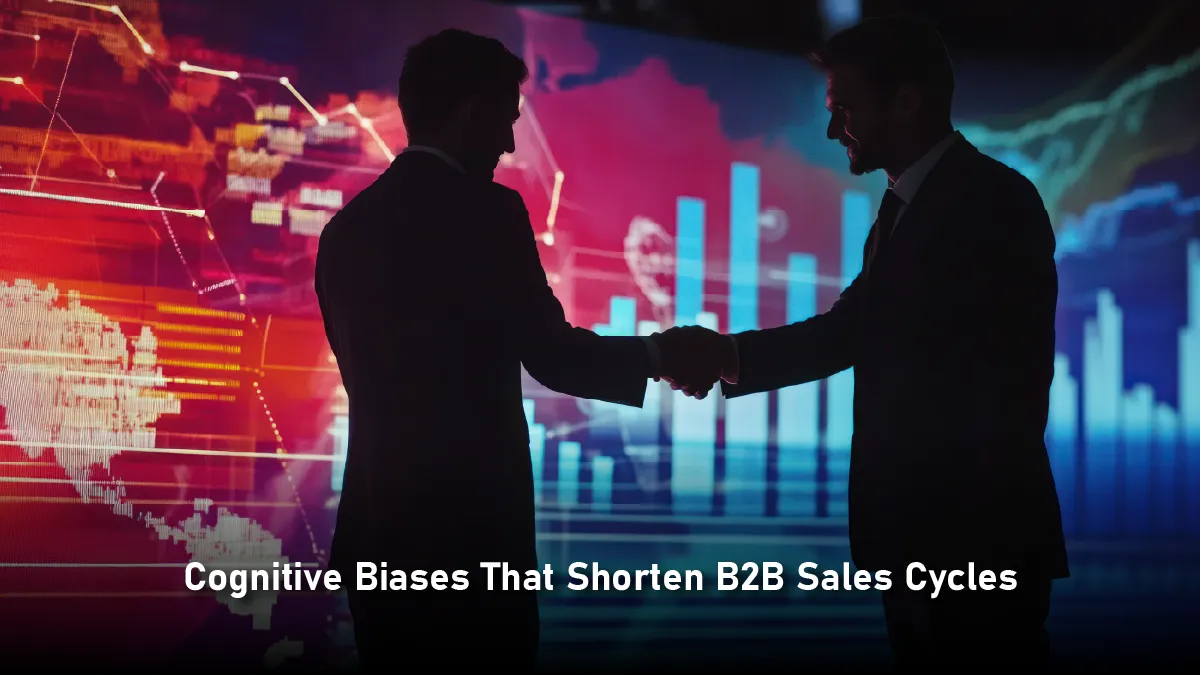In B2B marketing, speeding up conversions can feel like finding your way through a maze. Decision-makers are cautious, committees are risk-averse, and sales cycles stretch for months. Yet, some companies consistently close deals faster than others. The secret? They don’t just optimize their funnels—they hack the psychology of their buyers.
Each click, form submission, and contract signature ties to emotions, biases, and social factors. Knowing these psychological levers isn’t about tricking buyers. It’s about matching your strategy to how they really decide. This article reveals the mental shortcuts, fears, and motivations that shape B2B buying. Smart marketers can use these insights to speed up sales cycles and increase revenue.
The Myth of Rational Decision-Making in B2B
Conventional wisdom paints B2B buyers as purely logical actors—evaluating spreadsheets, comparing ROI, and prioritizing features. But neuroscience tells a different story. Studies show that even in high-stakes B2B decisions, emotions drive 95% of purchasing behavior, with logic used to justify choices post-hoc.
Take this example: A CIO evaluating cloud providers might cite cost savings as their deciding factor. In reality, their choice could be subconsciously influenced by a competitor’s recent breach (fear of risk), a colleague’s recommendation (social proof), or the vendor’s seamless demo experience (cognitive ease).
Ignoring these hidden forces leaves revenue on the table. Let’s explore how to design sales funnels that speak to both the conscious and subconscious minds of B2B buyers.
Cognitive Biases That Shorten B2B Sales Cycles

The Scarcity Principle: Creating Urgency Without Pressure
Scarcity triggers a primal fear of missing out (FOMO), pushing buyers to act before opportunities vanish. But in B2B, blatant countdown timers or “limited-time offers” often backfire, eroding trust with executive audiences.
The fix? Strategic scarcity. For instance, a cybersecurity firm struggling with slow demo requests started offering personalized threat assessments exclusively to the first five enterprises that signed up each quarter. By framing scarcity around relevance (“tailored for companies in your industry”) rather than time, demo bookings jumped 40%.
Authority Bias: Leveraging Expertise to Build Credibility
B2B buyers gravitate toward vendors perceived as thought leaders. But authority isn’t just about logos on a website—it’s about demonstrating deep vertical expertise.
Consider how Salesforce dominates CRM: Their funnel is peppered with industry-specific webinars, Gartner rankings, and case studies featuring recognizable clients. A mid-sized logistics software company mirrored this approach by publishing a quarterly “State of Supply Chain” report with proprietary data. Prospects who engaged with the report were 3x more likely to request a demo, as the content positioned the brand as a trusted advisor.
Social Proof: The Power of Peer Influence
While case studies are standard, their impact wanes when they lack specificity. Decision-makers don’t just want success stories—they want proof that their peers succeeded.
A SaaS company targeting healthcare clients overhauled its testimonial strategy. Instead of generic quotes, they embedded video interviews with hospital CFOs discussing exact cost savings and implementation timelines. Conversions on their pricing page rose by 28%, as buyers saw themselves reflected in the narratives.
Loss Aversion: Framing Solutions as Risk Mitigation
B2B buyers fear loss more than they desire gain. A McKinsey study found that 60% of executives prioritize avoiding negative outcomes over achieving positive ones.
Reframing your value proposition around risk reduction can be transformative. For example, a compliance software vendor shifted their messaging from “Streamline audits” to “Avoid $2M+ FTC penalties with real-time compliance monitoring.” Landing page conversions for their free audit tool doubled in three months.
Also Read: Why B2B Marketers Should Prioritize Conversion Rate Optimization Over Traffic Growth
The Role of Trust in Accelerating Decisions
Trust is the currency of B2B sales, yet many funnels undermine it unintentionally. Complex jargon, opaque pricing, and slow response times signal disorganization, not reliability. Here’s how to engineer trust at every stage:
First Impressions: Speed and Simplicity
A slow-loading website or cluttered homepage overwhelms visitors, triggering cognitive overload. Google found that pages loading in 2 seconds have a 15% higher conversion rate than those taking 5 seconds.
An enterprise IT firm reduced their homepage’s bounce rate by 35% by cutting text by 60%, adding clear navigation labels, and embedding a one-click “Schedule a Security Audit” button above the fold.
Transparency: Preempting Skepticism
B2B buyers expect vendors to address objections early. A common pitfall? Hiding pricing details until late in the funnel.
When a fintech startup added a “Typical Implementation Timeline” section to their pricing page—including potential delays and costs—demo requests increased by 22%. By acknowledging implementation challenges upfront, they reduced perceived risk.
Consistency: Aligning Messaging Across Channels
Buyers interact with brands via email, LinkedIn, webinars, and sales calls. Inconsistent messaging breeds doubt.
A unified content strategy solved this for a data analytics provider. Their sales team used the same terminology as their whitepapers, and webinar slides mirrored their website’s value props. Over six months, average deal cycle time dropped from 94 to 67 days.
Case Study: How a Manufacturing Tech Firm Cut Sales Cycles by 50%
Veridian Industries (pseudonym), a provider of factory automation software, faced a common challenge: Their average sales cycle was 180 days, with prospects stalling after initial demos.
A psychological audit revealed three friction points:
- Anxiety about ROI: Prospects struggled to quantify potential efficiency gains.
- Committee Dysfunction: Multiple stakeholders had conflicting priorities.
- Status Quo Bias: Engineers resisted changing entrenched workflows.
- Veridian’s marketing team redesigned their funnel around these insights:
- ROI Visualization Tool: An interactive calculator let prospects input current downtime costs and see projected savings.
- Stakeholder-Specific Content: Tailored email sequences addressed CFOs (cost savings), plant managers (ease of use), and IT directors (integration timelines).
- Pilot Program: A low-risk “automate one assembly line free for 30 days” offer overcame status quo bias.
- Results? Sales cycles shortened to 90 days, and close rates improved by 33%.
Actionable Strategies to Apply Psychological Insights
Map the Emotional Journey
Buyers don’t just move through a funnel—they oscillate between confidence and doubt. Conduct win/loss interviews to identify emotional highs and lows. A content marketing agency used this data to create a “Confidence Booster” email series sent when prospects typically hesitated, reducing drop-offs by 19%.
Design for Cognitive Ease
Reduce mental strain with intuitive design. Simplify forms, use familiar layouts, and avoid jargon. A cloud storage provider increased free trial sign-ups by 45% by replacing “Start Your 14-Day Trial” with “See How It Works in 2 Minutes.”
Harness the Halo Effect
Early positive experiences color later perceptions. Offer immediate value, like a personalized benchmark report or a quick-win tutorial. A DevOps platform grew demo bookings by 50% by offering a 5-minute “Infrastructure Health Check” before scheduling meetings.
Prime Prospects with Pre-Suasion
Psychologist Robert Cialdini’s concept of “pre-suasion” involves setting the stage for agreement before making an ask. For example, a cybersecurity vendor starts demos with industry-specific breach statistics, priming prospects to view their solution as essential.
The Pitfalls of Ignoring Buyer Psychology
Overlooking psychological drivers doesn’t just slow conversions—it can derail deals. Common mistakes include:
Overloading with Features: Bombarding prospects with technical specs triggers analysis paralysis.
Assuming Homogeneity: Treating all stakeholders as a single entity ignores their unique fears and goals.
Neglecting Post-Purchase Anxiety: Even after signing, buyers need reassurance. A lack of onboarding support can lead to buyer’s remorse and churn.
Conclusion: Building Funnels That Speak to the Human Brain
B2B marketing isn’t a battle of products; it’s a battle of perceptions. By leveraging the invisible forces that shape decision-making—scarcity, authority, trust, and loss aversion—marketers can craft funnels that don’t just guide buyers, but resonate with them.
The key lies in empathy. Before tweaking another landing page or launching a new campaign, ask: What does my buyer feel at this moment? How can I ease their fears, validate their instincts, and align my solution with their identity as a decision-maker?
In a world where competitors are a click away, psychology isn’t just a differentiator—it’s the foundation of sustainable growth.

